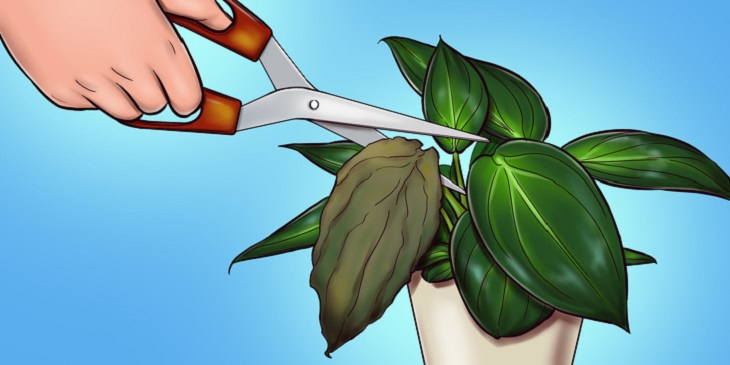Is your plant showing signs of browning leaves or yellow edges? These could indicate issues like inadequate watering, improper sunlight exposure, or the presence of harmful fungi. But how can you interpret these signals and nurse your beloved plant back to its former glory? To help you out, we've put together a comprehensive guide for all you plant enthusiasts. It covers eight signs of plant sickness and provides solutions to restore their health and beauty.
1. Fully brown leaves
Typically, fully brown leaves are a natural part of a plant's aging process and not a cause for concern related to care or environmental conditions.
What to do: Since these leaves are essentially dead and draining the plant's energy, there's no need to keep them. Simply trim them off with a knife or scissors.
2. Leaves with a brown tip
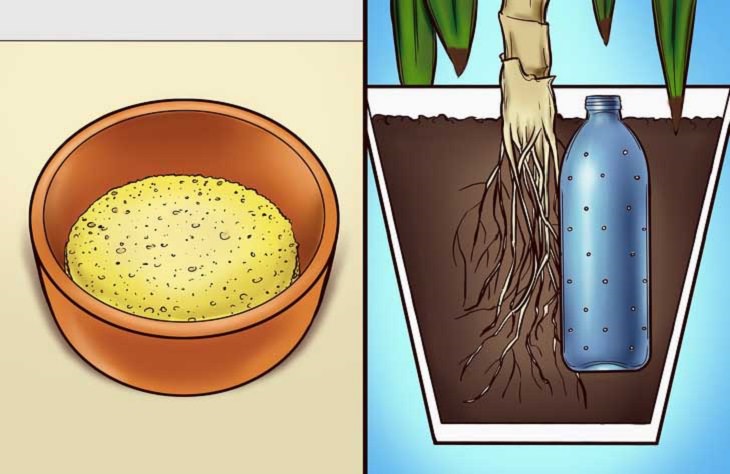
Leaves with a brown tip indicate insufficient water supply to the plants. This occurs due to the process of fluid transfer within the plants. When watering potted plants, water travels from the soil through the roots to the rest of the plant, including the leaves. Insufficient water in the plant and soil primarily affects the leaves, causing browning at the tips. This phenomenon indicates several potential problems, including infrequent watering, poor-quality soil that cannot absorb water effectively, and damaged roots due to over-watering or lack of space in a small pot.
To address this issue, there are two solutions to maintain proper soil moisture:
1. Placing a sponge at the bottom of the pot, which absorbs excess water and releases it when the plant requires hydration.
2. Inserting a plastic bottle with small holes into the soil allows the plant to drink water as needed.
3. Brown spots in the middle of the leaves

Sometimes we worry about overwatering our plants, which can lead to fungal growth and the appearance of brown spots in the center of the leaves. These spots can spread toward the edges of the leaves if the issue is not addressed.
What you can do: Allow the top 5 inches of soil to dry out before watering your plants again, and avoid leaving the pot flooded with water. If the soil remains consistently wet even after watering, it may be necessary to adjust the amount of water used. Using coffee filter papers at the bottom of the pot or planter can help drain excess water and maintain a healthy level of humidity for the plant.
4. Yellowing leaves

It is not uncommon for older plants to experience this phenomenon, so if you have been caring for some plants for a long time, don't be surprised if their leaves turn yellow and fall off. However, if this occurs in younger plants and affects multiple leaves, it is likely due to issues with watering, placement of the pot, temperature fluctuations, or dry weather. If only the upper leaves of your potted plant turn yellow while the rest remain green, the problem may be an excess of calcium in the watering water.
To address the issue, first, find the optimal location for your plant. However, avoid moving it too frequently as plants take time to adapt to new environments. If the problem is related to excessive calcium, consider changing the source of your irrigation water.
5. leaves with dark spots and yellowing edges
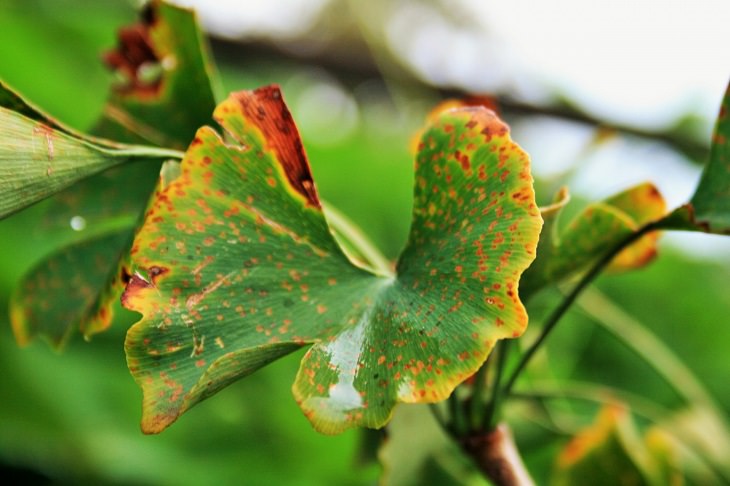
Similar to what we described in section 3, the presence of dark spots on the leaves is often caused by the growth of fungi, which occurs in hot and humid weather. This condition may also indicate excessive exposure to sunlight.
To address this issue, if the plant is potted indoors, it is recommended to isolate it from other plants to prevent further infection. Additionally, ensure that the plant is not placed too close to windows to eliminate the possibility of sun exposure as the cause of the spots. Trim off the infected leaf and allow the rest of the plant to heal.
If the plant is grown in a yard or garden, you can consider fertilizing it with sulfur and copper-based substances. Another option is to use a homemade natural solution consisting of ½ teaspoon of baking soda powder mixed with 4 liters of water to treat the plant.
6. Leaves with pale edges
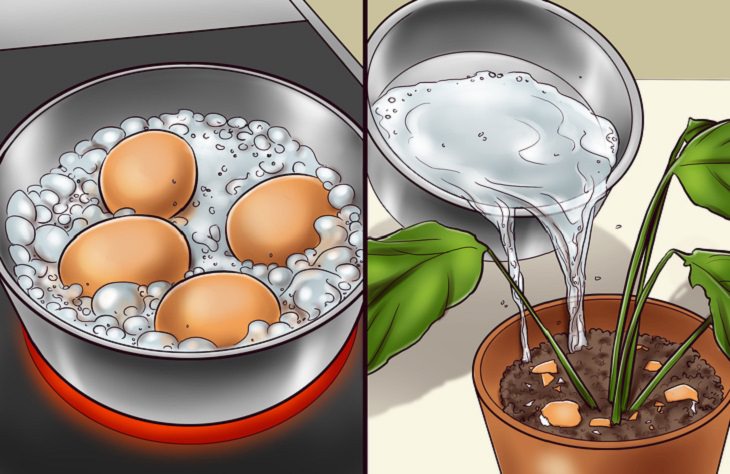
If you notice that the edges of your plant's leaves have suddenly turned pale or yellow, it could be a sign that they are lacking essential nutrients. This can happen when the plant is unable to absorb the necessary minerals from the soil due to factors like high acidity, dryness, or water evaporation.
To address this issue, you can use eggshells as a natural solution. Eggshells are rich in calcium and potassium, which are beneficial for plants. Simply add 5 dry eggshells, either whole or crushed into powder, to the soil of the plant once a week. Another option is to water the plant regularly with water that has been used to soak hard-boiled eggs overnight.
7. Leaves are too small
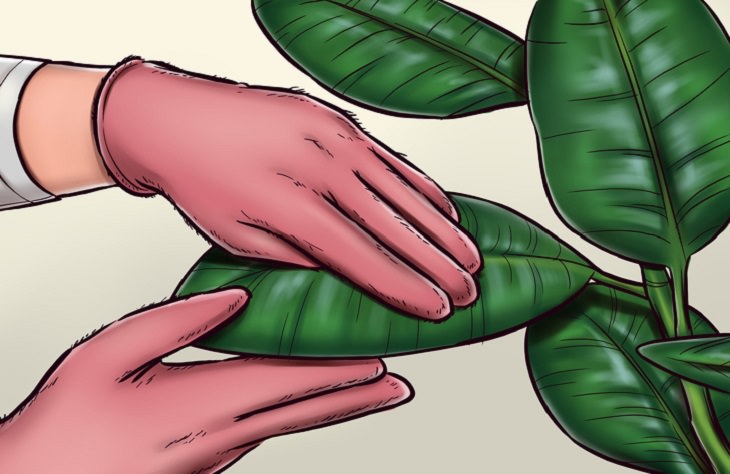
During the initial stages of your plant's growth, it displayed large and beautiful leaves. However, you may have noticed that the newer leaves are now smaller in size. This could be a result of insufficient sunlight, causing the plant to produce smaller leaves that require less energy and effort. Even if you have placed the pot near a window and it receives adequate light, it is possible that a layer of dust has accumulated on the leaves, hindering the penetration of sunlight and reducing the plant's ability to photosynthesize effectively.
To address this issue, you can take a few steps. If the problem is indeed due to lack of sunlight, consider relocating the pot to a spot near a window or in a brighter area. If sunlight is not the issue, you can put on soft gloves and gently remove the dust that has settled on the leaves. By doing so, you will help the plant regain its ability to thrive and grow.
8. Curly edges
Some of the plants we purchase and bring into our homes or offices originate from tropical regions with high levels of humidity. However, these plants may struggle to adapt to the lower humidity and limited space in our indoor environments. Consequently, their leaves may develop unsightly curves, giving the plants a neglected appearance.
To prevent this, it is important to avoid placing your plant pots near vents or heat diffusers, as these can damage the plants. Additionally, you can enhance the humidity level around your plants by grouping several pots together, regularly misting them with water, and increasing the frequency or quantity of watering. However, it is crucial to exercise caution and avoid excessive watering.

